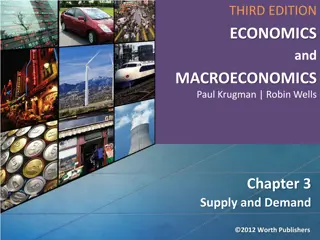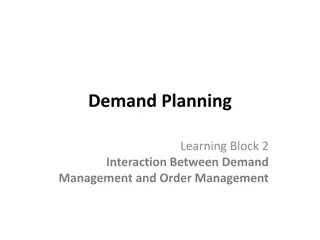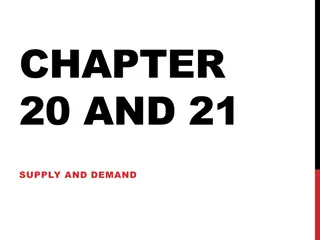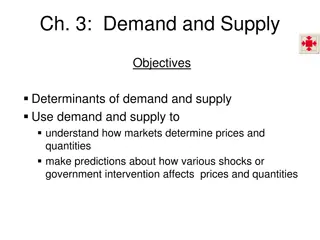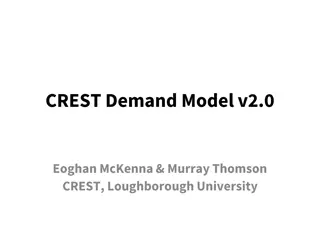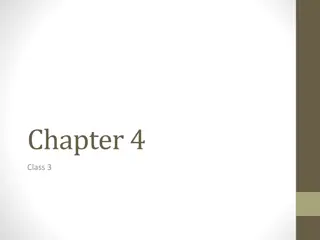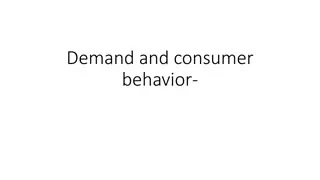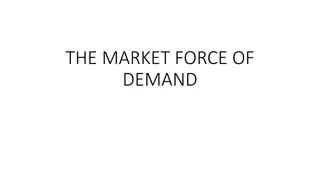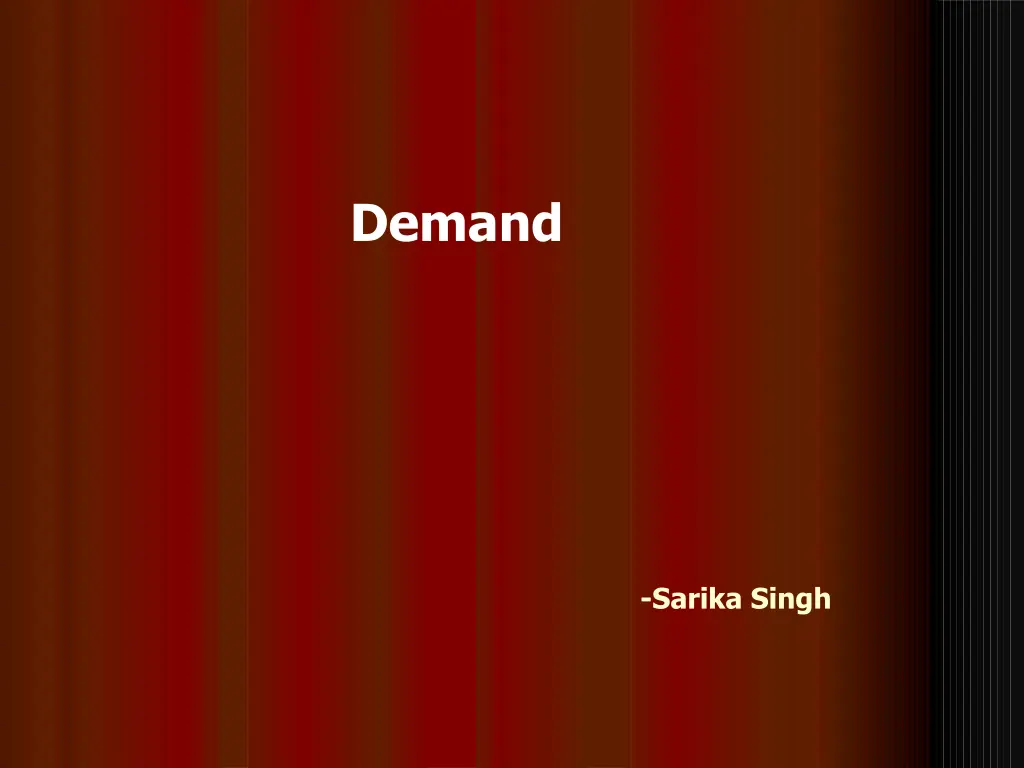
Understanding Demand: Analysis and Function
"Learn about the meaning of demand, the law of demand, assumptions, demand schedule, and demand function through detailed analysis. Explore individual and market demand along with graphical representations and numerical tabulations." (264 characters)
Download Presentation

Please find below an Image/Link to download the presentation.
The content on the website is provided AS IS for your information and personal use only. It may not be sold, licensed, or shared on other websites without obtaining consent from the author. If you encounter any issues during the download, it is possible that the publisher has removed the file from their server.
You are allowed to download the files provided on this website for personal or commercial use, subject to the condition that they are used lawfully. All files are the property of their respective owners.
The content on the website is provided AS IS for your information and personal use only. It may not be sold, licensed, or shared on other websites without obtaining consent from the author.
E N D
Presentation Transcript
Demand -Sarika Singh
Demand Analysis Meaning of Demand: Demand for a particular commodity refers to the commodity which an household is willing to purchase per unit of time at a particular price. Demand for a particular commodity implies: Desire of the customer to buy the product; The customers willingness to buy the product; Sufficient purchasing power in the customers possession to buy the product. individual consumer or household is known Individual demand for Summation of the individual demand is known as the Market demand. individual consumer or The demand for a particular commodity by an as the commodity and
Demand Analysis Law of Demand: Law of relationship demanded commodity. The law of demands states that, Ceteris Paribus, remaining constant) the lower the price of a commodity the larger the quantity demanded of it and vice versa. In simple terms other things remain constant, if the commodity increases, will decrease and if the price of the commodity decreases, will increase. demand between and expresses the Price the Quantity of P 1 Qd 60 the the 2 3 4 50 40 30 (other things price of demand the the the demand
Demand Analysis Assumptions: No change in taste and preference. Income of the consumer is constant. No change in customs, habit, quality of goods. No change in substitute products, related products and the price of the product. No complementary goods. 4
Demand Analysis Demand Schedule: A demand schedule is a numerical tabulation that shows the quantity of demeaned commodity at different prices. The demand schedule may be of 2 types : Individual demand Schedule Market demand Schedule. 5
Demand Analysis Table Showing the IDC & MDC : Price (Per Kg) Quantity demanded by Market Demand Individual Customers A B C D 6 7 8 9 4 3 2 0 3 2 1 0 5 4 3 1 6 19 14 10 03 5 4 2 6
Demand Analysis Graphical Representation of IDC & MDC 7
Demand Analysis Demand Function: A Mathematical relationship between quantity demanded of the determinants is known as Demand Function. When this relationship relates to the demand by an individual consumer it is known as Individual demand function and while it relates to the market its known as market demand function. Individual Demand Function : Qdx = f (Px, Y, P1 . Pn-1, T, A, Ey. Ep, U) commodity and its
Demand Analysis = Quantity demanded for product X. = Price of product X = Level of Income = Prices of all other products Qdx Px Y P1..Pn-1 T A Ey Ep U = Taste of the consumer = Advertisement = Expected future income = Expected future price = Other determinants not covered in the list of determinants. Market Demand Function: Qdx = f (Px, Y, P1 . Pn-1, T, A, Ey, Ep, P, D, U, P) P = Population D = Distribution of consumers. 9
Demand Analysis Causes of downward sloping of Demand Curve: According to the law of demand there relationship between the DEMANDED, and that is why demand curve is downward sloping. Let the linear form of demand curve : P = a + bq, where a, q constant and b < 0, i.e. dp/dq = b < 0 (Assumption), so slope of the demand curve is negative. The various reasons for this downwards sloping of demand curves are as follows: Law of Diminishing Marginal Utility and Equi-Marginal utility. Price Effect. Income Effect. Substitution Effect. Different Use ( Electricity). exists a opposite the QUANTITY PRICE and
Demand Analysis Exceptions of Law of Demand: In certain cases the slope of Demand Curve is upward i.e. positively sloped, it is known as the exceptions of Law of Demand. These exceptions are as follows: Giffen Goods (Giffen Paradox) Emergency (War etc ) Conspicuous necessities (Car, Fancy Cloths etc ) and Conspicuous Consumption (Fancy Diamonds, High price shoes, pens etc ) Depression ( Price and quantity demand is low) Ignorance Effect (High priced commodity is better in quality) Speculation (Future change in price)
Demand Analysis The Individual s demand depends on the demands of the other people. Bandwagon Effect (Positive Network Externality) : Flatter or more elastic Snob Effect: (Negative Network Externality): Steeper or Less elastic Veblen Effect : Steeper or Less elastic Shift (Contraction & Expansion) and Change in Demand: situations given below are the cases where
Demand Analysis Factors Determining Demand: General Factors: Price of the product Taste and Preference Income Prices of the related goods Additional Factors: (Luxury Goods & Durables) Consumer s Expectation of future price. Consumer s Expectation of future income. Additional Factors:( Market Demand) Population Social, Economic Consumer s. & Demographic distribution of
Demand Analysis Demand Distinctions: Producer s Good and Consumer s Good. Durable and Perishable Good. Derived Demand Autonomous Demand. Industry Demand and Firm (Company) Demand. Total Demand and Market segment Demand Short Run Demand and Long Run Demand. Short Run Demand Fluctuations and Long Run Demand Trends.
Demand Analysis Problems: The demand equation is Q = 90 3P. At what price would no one be willing to buy any of the commodity? If the commodity is given free, what is the quantity demanded? If the price is reduced by 1 unit how much the quantity demanded change? The demand equation is Q = 25 5P. What is the quantity demanded if the price is Rs 3? Assume the demand is 18 units, then what is the corresponding price? What would be the demand if the commodity in question were a free good? What is the highest price commodity? 2. 3. anybody will pay for the










